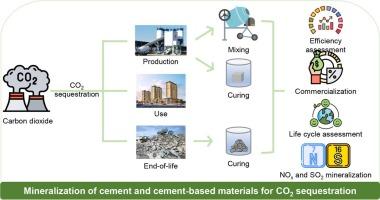从实验室到工业规模:如何评价水泥和水泥基材料的碳矿化
IF 11.2
1区 社会学
Q1 ENVIRONMENTAL STUDIES
引用次数: 0
摘要
水泥生产是全球二氧化碳排放的主要来源。碳矿化为水泥和水泥基材料(CCM)的全生命周期减排提供了一条有希望的途径。本研究通过综合反应机制、固存效率、技术经济约束和政策考虑,系统地评估了CCM的矿化潜力。该工艺通过与Ca(OH)2、C-S-H和未水合熟料的反应将CO2转化为稳定的CaCO3,在热力学上是有利的,动力学上是可调的。不同的碳化机制在不同的阶段起作用——混合过程中的早期碳化,固化过程中的强度和耐久性提高,以及回收骨料在使用寿命结束时的孔隙填充。不同阶段的固碳效率不同:混合低(0.616-2.21 kg/m3),固化高(35.0-113.47 kg/m3), RCA处理中等(16.9-58.0 g/kg骨料)。虽然气体扩散限制和竞争性吸附等挑战仍然存在,但NOx和SOx的共同封存进一步提高了环境性能。虽然自然碳化抵消了30 - 55%的过程排放,但全面加速碳化每年可封存高达4.83亿吨二氧化碳。工业应用仍然受到二氧化碳捕获物流、烟气纯度和基础设施需求的限制。高昂的资本成本——尤其是固化系统——需要支持性政策、碳定价和优化物流。生命周期评估(LCA)确认了环境效益,特别是二氧化碳固化。然而,成功的大规模实施将需要在材料科学、工艺设计和监管框架方面进行协调创新,以充分发挥基于ccm的矿化技术的减缓潜力。本文章由计算机程序翻译,如有差异,请以英文原文为准。

From laboratory to industrial scale: How to evaluate the carbon mineralization of cement and cement-based materials
Cement production is a major source of global CO2 emissions. Carbon mineralization presents a promising pathway for emission reduction across the lifecycle of cement and cement-based materials (CCM). This study systematically evaluates the mineralization potential of CCM by integrating reaction mechanisms, sequestration efficiencies, techno-economic constraints, and policy considerations. The process is thermodynamically favorable and kinetically tunable, converting CO2 into stable CaCO3 through reactions with Ca(OH)2, C-S-H, and unhydrated clinker. Distinct carbonation mechanisms operate at different stages—early-age carbonation during mixing, strength and durability gains during curing, and pore filling in recycled aggregates at end-of-life. Sequestration efficiency varies by stage: low in mixing (0.616–2.21 kg/m3), high in curing (35.0–113.47 kg/m3), and moderate in RCA treatment (16.9–58.0 g/kg aggregates). Co-sequestration of NOx and SOx further enhances environmental performance, though challenges such as gas diffusion limitations and competitive adsorption persist. While natural carbonation offsets 30–55 % of process emissions, fully scaled accelerated carbonation could sequester up to 483 Mt. CO2 annually. Industrial application remains limited by CO2 capture logistics, flue gas purity, and infrastructure demands. High capital costs—especially for curing systems—require supportive policy, carbon pricing, and optimized logistics. Life cycle assessments (LCA) confirm environmental benefits, especially with CO2 curing. However, successful large-scale implementation will require coordinated innovation in materials science, process design, and regulatory frameworks to realize the full mitigation potential of CCM-based mineralization technologies.
求助全文
通过发布文献求助,成功后即可免费获取论文全文。
去求助
来源期刊

Environmental Impact Assessment Review
ENVIRONMENTAL STUDIES-
CiteScore
12.60
自引率
10.10%
发文量
200
审稿时长
33 days
期刊介绍:
Environmental Impact Assessment Review is an interdisciplinary journal that serves a global audience of practitioners, policymakers, and academics involved in assessing the environmental impact of policies, projects, processes, and products. The journal focuses on innovative theory and practice in environmental impact assessment (EIA). Papers are expected to present innovative ideas, be topical, and coherent. The journal emphasizes concepts, methods, techniques, approaches, and systems related to EIA theory and practice.
 求助内容:
求助内容: 应助结果提醒方式:
应助结果提醒方式:


